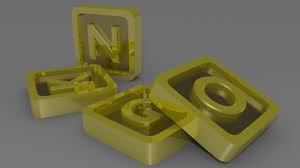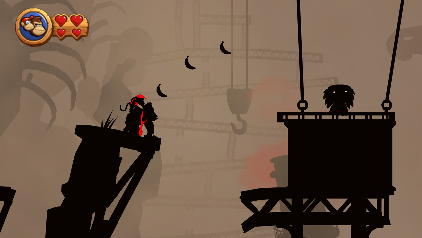Donkey Kong Country: Returns pt.2
 Saturday, December 18, 2010 at 1:03PM
Saturday, December 18, 2010 at 1:03PM Level Design
The Donkey Kong Series has never played like the Mario Bros series (2D platformers). Mario's core gameplay is centered on a counterpoint between Mario, enemy, and level elements. How you handle enemies can affect the level elements and the challenges they create. How you transform the level can change how the enemies move/attack. If Mario levels are like playgrounds then Donkey Kong levels are generally more like park rides with a strong forward drive of timing challenges that are fairly simple. At least, this is how DKC and DKC2 are designed. The DK:Jungle Beat developers designed everything from the ground up in a new style that's clearly has the same stamp of creativity as Mario Galaxy. Though, like Mario, DK levels are designed in layers. And the design philosophies behind DKCR's layers is where Retro Studios innovates and modernizes the series.

Secrets/Collectibles
Each level in DKCR has more secrets than in the original DKC games. This is probably because the levels are larger. Taking a page from Mario's secret design Retro increased the range of secret types in DKCR. The objects players can BLOW/GROUND POUND to reveal a secret are the equivalent to Mario's ?-blocks. The KONG pieces are more like red coins from Yoshi's Island in that they must all be obtained in a single attempt at a level. And the puzzle pieces are like NSMB star coins.
In classic DKC fashion, bananas are arranged to encourage an optional challenge and guide players safely through a level when the camera can't frame the scene properly. Bananas also hint to secrets. Hanging bags can only be busted with barrels that must be carried (suspension) from another point in the level. Finally, Retro has shifted away from the kind of secrets that can only be discovered with great luck, lots of trial and error, or a player's guide. Now we know how many puzzle pieces there are per level and getting 100% is a practical achievement.
Time Trials/Speed Runs
The Donkey Kong Country series is no stranger to speed runs. Even as a kid, I worked on getting my final game time below an hour. Like Mario, levels are generally tuned to support speedy play in that paths are designed to be open for the player moving at top speeds. DKCR makes this design layer even more clear. The gold, silver, and bronze medals encourage players to push themselves to discover a whole new "level" of platforming possibilities to cut down times. Once your eyes are opened to speed, you'll notice all kinds of alternate paths and enemies positioned just to help the fastest players progress faster. The time trial mode is a good example of getting more gameplay out of each level (compressing space).
The average level in DKCR contains more varied and complex timing challenges than in DKC for the SNES. With more moving platforms, flying projectiles, enemies, new JUMPing off enemies mechanic, and a wider screen view DKCR creates complex timing challenges naturally. Also, getting the most out of the mechanics takes more knowledge, dexterity, and timing skills. But gameplay challenge alone isn't the only factor that determines a game's difficulty. How forgiving the challenges are, how easy it is to stockpile extra lives, and how frequently one can save their progress are all important factors to consider.
In DKCR all progress auto saves. And like Mega Man 9, players can spend game currency to make things easier. If you need more lives, buy them. If you need invincibility use it. Regardless of how many hearts you have or how invincible you are, pits and 1 hit kills are the most deadly. The limited air control and ROLL momentum makes falling to death harder to avoid than ever. Besides, all the items in the world can't do anything to help you collect secrets, makes pits less deadly, or get golds in time trials. So even if you think reducing the difficulty with purchased items is too effective, beating the level is just a small part/layer of each level's total experience.
In single player, players start with DK and 2 hearts (on the 2nd hit you die). Grabbing a DK barrel earns a Diddy powerup! Like all powerups, Diddy is designed to help players undermine challenges. With Diddy, players get 2 more hearts, the KONG ROLL mechanic, and a jet pack. Being able to hover with the jet pack does make platforming a bit easier, but it's still possible to miss moving platforms because the horizontal hover speed is much slower than the ROLL-JUMP speed. Rambi is a powerup that's designed like vehicles in Halo in that the new actions are mapped to the same controls so players can quickly adjust. ROLL = RUSH. JUMP = JUMP. GROUND POUND = RAMBI STOMP.
The real hard mode in DKCR is co-op multiplayer. In co-op you burn through lives twice as fast when you die in mine carts or barrel rockets. Outside of these moments there are times when the fate of one player is linked to the other (like when traveling via barrels). But beyond this drawback, the following are (p)layered (article 2) design elements that make playing 2 players inherently more difficult than playing solo.
- The camera follows the player in the lead. When platforming around, it's natural to aim based on your character's relative position to the target in addition to judging speed based off the scrolling camera. So when the camera switches between players to follow, you can lose your bearings.
- Any off screen player will be teleported back into frame after about 5 seconds. During this count down, the off screen player is still vulnerable to attack. When the timer goes off, they'll move to the exact potions of the on screen player. This can be dangerous of the on screen player is JUMPing over a pit.
- Weight/physics based platforms are tricker with 2 players (6-3 Weighty Way). From balancing out on both ends of a seesaw like platform to coordinating jumps to get a platform to lift, there's a whole range of altered platforming challenges created from there being 2 characters.
- Some enemies become more dangerous with 2 players. The dinosaur skeleton in particular launch their heads to the side after they're JUMPed on. This flying head can be especially difficulty for a second player to avoid considering air maneuverability isn't very high.
- Crumbling/falling platforms and mine carts activate whenever one player touches them. If players don't wait/work together, the player who lags behind might be doomed to a fall.
For these reasons, DKCR may be best experienced solo unless the co-op players are already familiar with the game.

Style and Inspiration
The result is a game with levels that are packed with content and flexible enough to present dazzling set pieces and a wide variety of well developed gameplay ideas. Some levels have LittleBigPlanet influences like the snake boss at 5-B Mangoruby Ruin. Some of the bonus stages are designed similarly to NSMBWii bonus stages. The Cliff world features several physics based platforming puzzles/challenges that remind me of Trine (6-3). The 7-6 Switcheroo and the 7-7 Music Madness level remind me of great Super Mario Galaxy 2 levels. Yet, at the same time, the gameplay is distinctly DK. From the barrel timing challenges, to the roller coaster style mine cart levels, to the new jet barrel levels that are similar to the water levels of DKC, the gameplay experience is still focused on interesting environments, level elements, and flashy set pieces.
Though some of the later levels look less interesting/detailed than the beginning levels, Retro has done a great job creating a rich, distinct look for this DK reboot. Style wise, some of the enemies look bland, uninspired, and/or flat on detail (moles, snakes). Charm wise the Kongs could use a bit more prankster spirit. After all, DK flipped Diddy's hat over his eyes and Diddy stepped on DK's foot in good fun. And where is all the monkey dancing?
Camera design and presentation wise, DKCR uses depth and zoom to enhance the presentation of 2D space. Toward the end of the level 1-1, players are launched into the background platforms. This is more than just a visual trick. Because the scale is smaller, players can see more on screen at once aiding platforming. On an aesthetic level the size and design of the tower that DK climbs before shooting back into the foreground is communicated instantly. In other levels, DK moves in closer to the camera to reduce the field view to create tension by reducing the time players have tor react. In other examples, the camera smoothly pans out to achieve a similar effect.
For a perfect example of style and substance, the shilhouette levels like 1-4 Sunset Shore are some of the most visually impressive levels, but the shadowy shapes are designed to create look-alike mixups. There are enemies that look like bushes and GROUND POUNDable platforms that are further obscured by the shadowy darkness. In other words, familiar visual tells are removed making this simple level uniquely challenging. In 7-1 Foggy Fumes, the industrial fog conceals and reveals elements to make a relatively simple level more interesting.
Conclusion
Donkey Kong Country Returns returns to the design style of the original DKC games and innovates across the entire design. The difference between Donkey Kong and Mario can be expressed in their version of "super play." DKCR shines via the speed run, or a play through of a level optimized for fast times. New Super Mario Bros. Wii's superplays include speed runs, alternate paths, grabbing secrets in neat ways, and cool tricks. The greater range of expression possible in Mario is due to a more freestyling-emergent-counterpoint-level design. For DKCR, I agree with just about every design decision made by Retro (except that lame robot chicken boss on 7-B Feather Fiend). DKCR is a well made game in its own style that can sit side by side with greats like NSMBWii.
Welcome back DK. You too Diddy.

